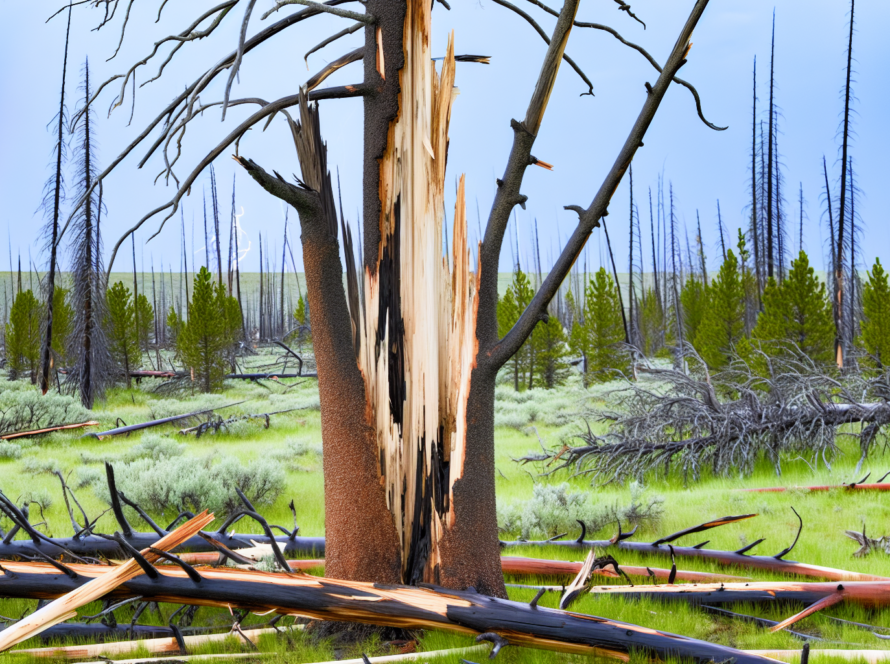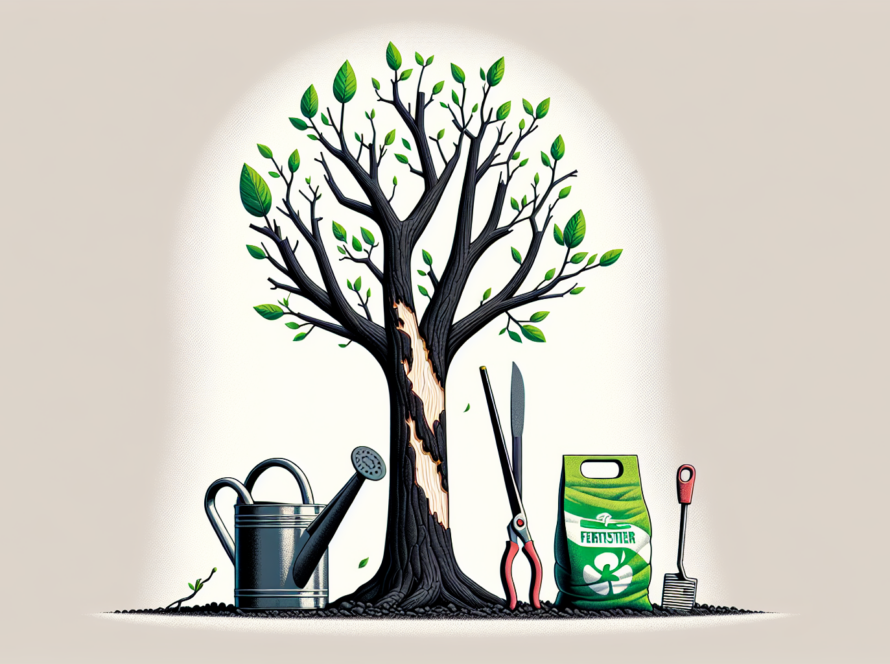Who is responsible for fallen tree removal? This critical question arises when a tree falls on or near your property. Our article cuts straight to the chase, outlining the responsibilities based on property ownership, legal precedents, and specific scenarios that could affect liability.
Key Takeaways
Responsibility for fallen tree removal is influenced by factors such as property lines, tree ownership, and prior knowledge of the tree’s condition. Negligence by the tree owner can lead to liability.
Homeowners insurance usually covers damages from natural events, but may not cover tree removal costs if a tree falls due to negligence or if it doesn’t hit an insured property.
Professional tree removal services are recommended for fallen trees to ensure safety, and costs can vary based on multiple factors. Regular tree inspections and maintenance can prevent falls.
Determining Liability When a Tree Falls
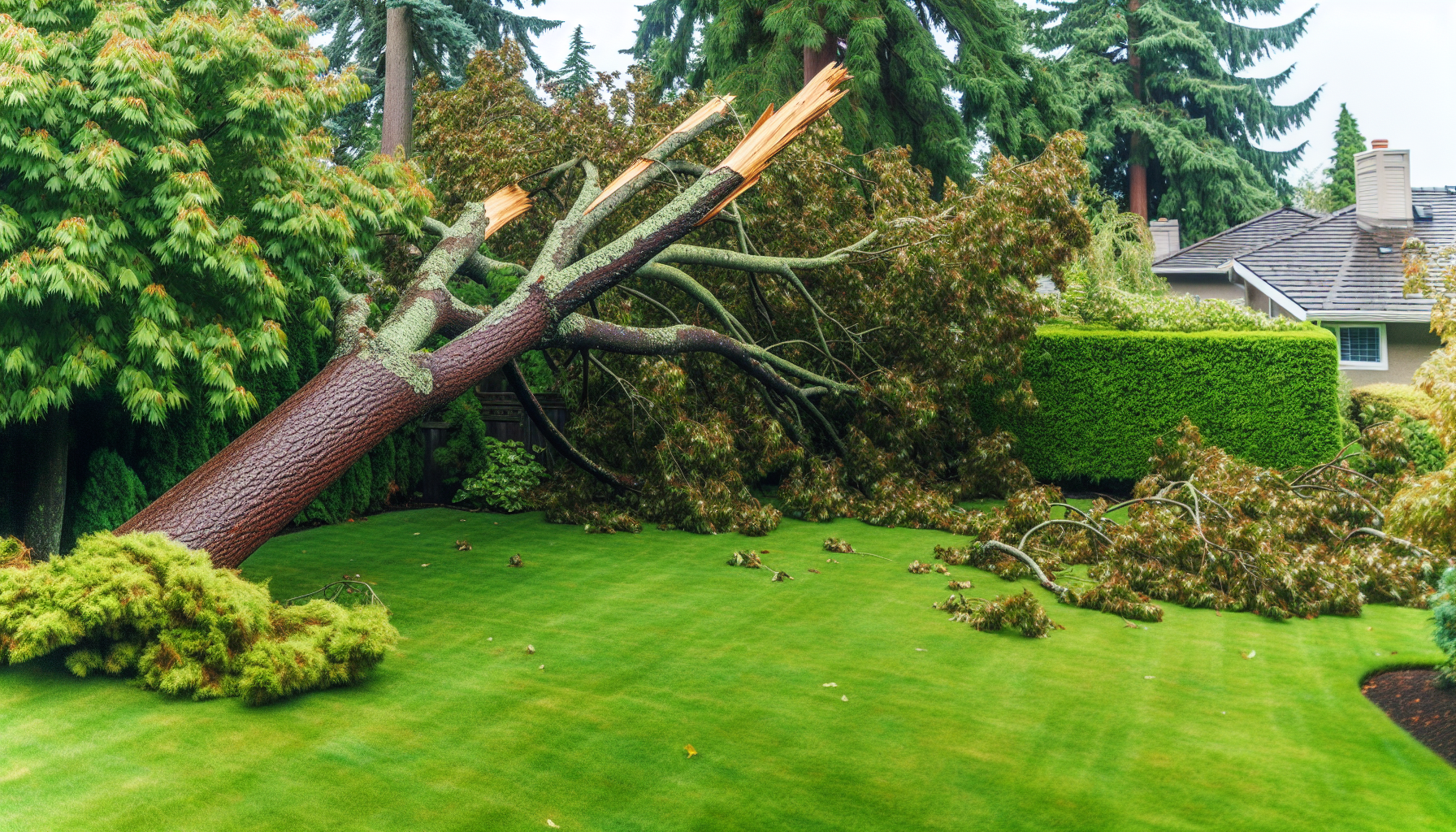
In the aftermath of a storm, or simply when a tree has reached its life’s end, the question of liability often arises. Determining responsibility for a fallen tree isn’t always as simple as it seems. It’s not just about whose property the tree landed on; there’s more to consider. Factors like property lines, ownership of the tree, and prior knowledge of the tree’s health all play a crucial role in determining liability for fallen tree removal.
Negligence is a key element in these scenarios. It’s not the easiest thing to prove, but if a tree owner has been negligent in maintaining their tree, they could be held responsible when the tree falls. For instance, if a neighbor’s tree falls due to negligence and causes damage, the neighbor’s insurance company is generally expected to cover the damages.
On the other hand, if a property owner was aware that a tree was diseased or dead and failed to take action, they could be held responsible for any damage caused to another’s property.
The Role of Property Lines in Fallen Tree Scenarios
Property lines cast a significant influence on the responsibility of fallen tree removal. These lines vary depending on the state, municipality, and whether the area is urban or rural. But what happens when a tree’s branches hang over the line, or even worse, when the entire tree falls over it?
As a property owner, you have the right to trim branches hanging over your property line. However, you can’t cut down the entire tree. This right also comes with a responsibility to not compromise the health of the tree in the process. If a tree’s origin lies within public right-of-way areas, the city might shoulder the removal responsibilities.
The interplay of property lines, tree falling scenarios, fallen tree situations, and neighbor’s property can be a complex puzzle, often requiring a keen understanding of local laws and policies when a tree fell.
Identifying the Tree Owner and Their Duties
Ownership brings responsibility, and tree ownership is no different. A tree owner is responsible for the care, pruning, and overall maintenance of trees that sit entirely on their property, ensuring their safe condition. This responsibility extends to handling the cleanup of tree debris from a tree whose canopy crosses property lines and lands on a neighbor’s property.
To ensure that tree owners fulfill their duties, a professional arborist can be of great help. They can identify diseased, dying, or dangerous trees, thereby assisting tree owners in maintaining their trees and mitigating potential hazards.
By identifying the tree owner and understanding their duties, we can significantly reduce the risks and disputes associated with fallen trees.
Assessing Prior Knowledge of Tree Health
A tree’s health is a critical factor in determining liability for a fallen tree. Homeowners may be held liable if they were aware of the tree’s poor condition and didn’t take necessary action. But how does one assess a tree’s health?
There are several visual indicators of an unhealthy and unstable tree, such as:
Rotten roots
Slow growth
Premature leaf color changes
Wilting leaves
New lean developments, especially at an angle of 15 degrees or more
Presence of dead trees
If a tree exhibits any of these warning signs, it warrants an inspection for stability. Ignoring these signs can not only lead to a costlier removal process but also result in insurance claims being rejected, especially in the case of a dead tree.
So, regular assessment of tree health and prompt action are not only preventive measures but also a way to safeguard against potential financial loss.
Insurance Coverage and Fallen Trees
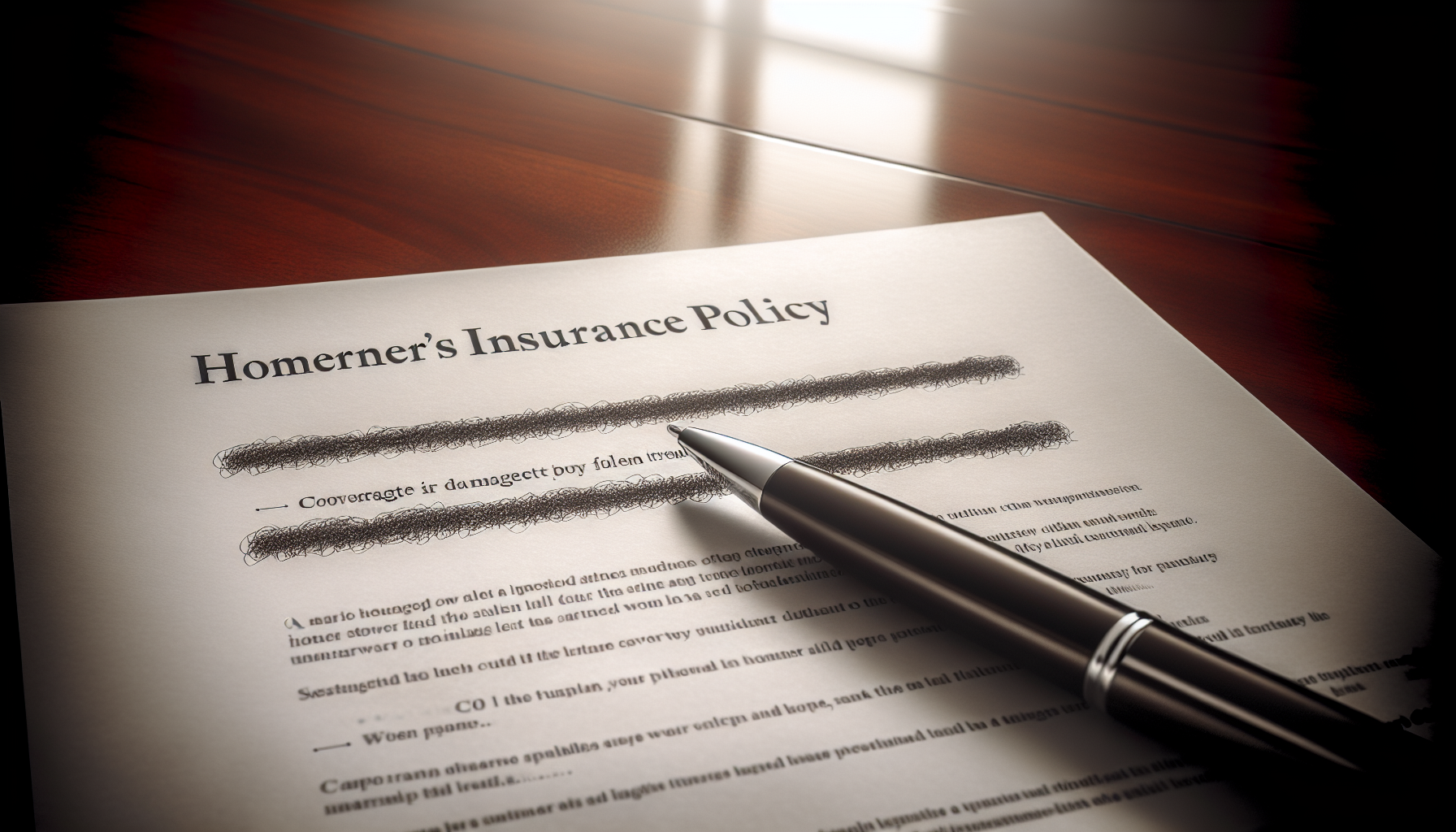
When it comes to fallen trees, homeowners insurance generally covers damages when a tree falls due to natural events such as high winds or storms. But does the insurance cover the tree removal costs too? The answer isn’t always a simple yes or no. It depends on the specifics of the incident and the details of your policy.
In most cases, tree removal costs may be covered if a fallen tree prevents access to your front door or driveway, or if it hits other structures on the property. However, the decision to cover these costs is subject to the insurer’s discretion.
It’s important to note that if a windstorm causes a tree to fall, it is typically not considered the fault of the homeowner, and such damage is usually covered by the homeowner’s insurance policy.
Understanding Your Homeowner’s Insurance Policy
Understanding your homeowner’s insurance policy is crucial in determining coverage for damage caused by a neighbor’s fallen tree. When a tree falls over a property line due to a covered peril, such as wind or winter storms, it’s typically the neighbor’s homeowner insurance that is responsible for the coverage.
However, the details of your homeowner’s insurance policy also matter. Depending on the specifics of your policy, coverage might be provided for damage caused by a neighbor’s fallen tree if you are considered liable. Therefore, understanding your policy is key to knowing when and how much coverage you can expect in such scenarios.
When Insurance Won’t Cover Fallen Tree Removal
Just as it’s important to know when your insurance will cover fallen tree removal, it’s equally crucial to understand when it won’t. For instance, if a tree falls due to negligence, such as lack of proper care or ignoring signs of disease, homeowner’s insurance likely will not cover costs for cleanup, removal, or repairs.
Furthermore, tree removal is usually not covered if the fallen tree did not hit insured property or cause structural damage. Also, events not covered by the policy, such as floods, earthquakes, or mudslides, will likely result in homeowners insurance not covering the removal of fallen trees. So, while insurance can be a lifesaver in many situations, it’s not a guaranteed solution for every fallen tree scenario.
Navigating Neighborly Disputes Over Fallen Trees
Trees don’t respect property lines, and when they fall, they can spark neighborly disputes. Navigating these situations involves a blend of communication, understanding legal recourse, and determining responsibility based on property lines and tree ownership.
Interestingly, homeowners are typically responsible for damages on their property, irrespective of where the fallen tree originated. So, if your neighbor’s tree falls and damages your house, it is usually your homeowners insurance that is expected to cover the damages. But what if your neighbor refuses to address a potentially dangerous tree that’s leaning precariously over your property? That’s where understanding your rights and responsibilities comes in handy.
Initiating Dialogue with Neighbors About Fallen Trees
When it comes to dealing with a neighbor’s tree threatening your property, the first step is to initiate dialogue. It’s best to approach your neighbors as allies, not adversaries, aiming to jointly solve the issue. Start by sharing your concerns about the neighbor’s tree and even offering to help with costs.
If your neighbor seems unresponsive or unwilling to take action, it’s time to resort to formal communication. A written letter, preferably sent via postal services for documentation, should outline your concerns, incorporate photographs, and prompt action.
In situations where direct communication doesn’t yield results, consider using a mediator like a mutual friend or a professional to facilitate discussions.
Legal Recourse When Dealing with a Neighbor’s Fallen Tree
While it’s always best to resolve tree disputes amicably, sometimes legal action may be necessary. Proving your neighbor’s liability may require you to show documented proof of prior requests for them to remove a problematic tree. If a tree or its branches fell due to the neighbor’s negligence, such as failing to address known problems with the tree, they could be held legally liable.
In such instances, you could sue for compensation. However, before taking legal action, it’s recommended to consider if the issue can be settled amicably as the neighbor may prefer to avoid court costs. Consulting with an attorney can provide guidance on the best course of action based on the attorney’s experience with similar cases.
Professional Tree Removal Services: Safety and Costs
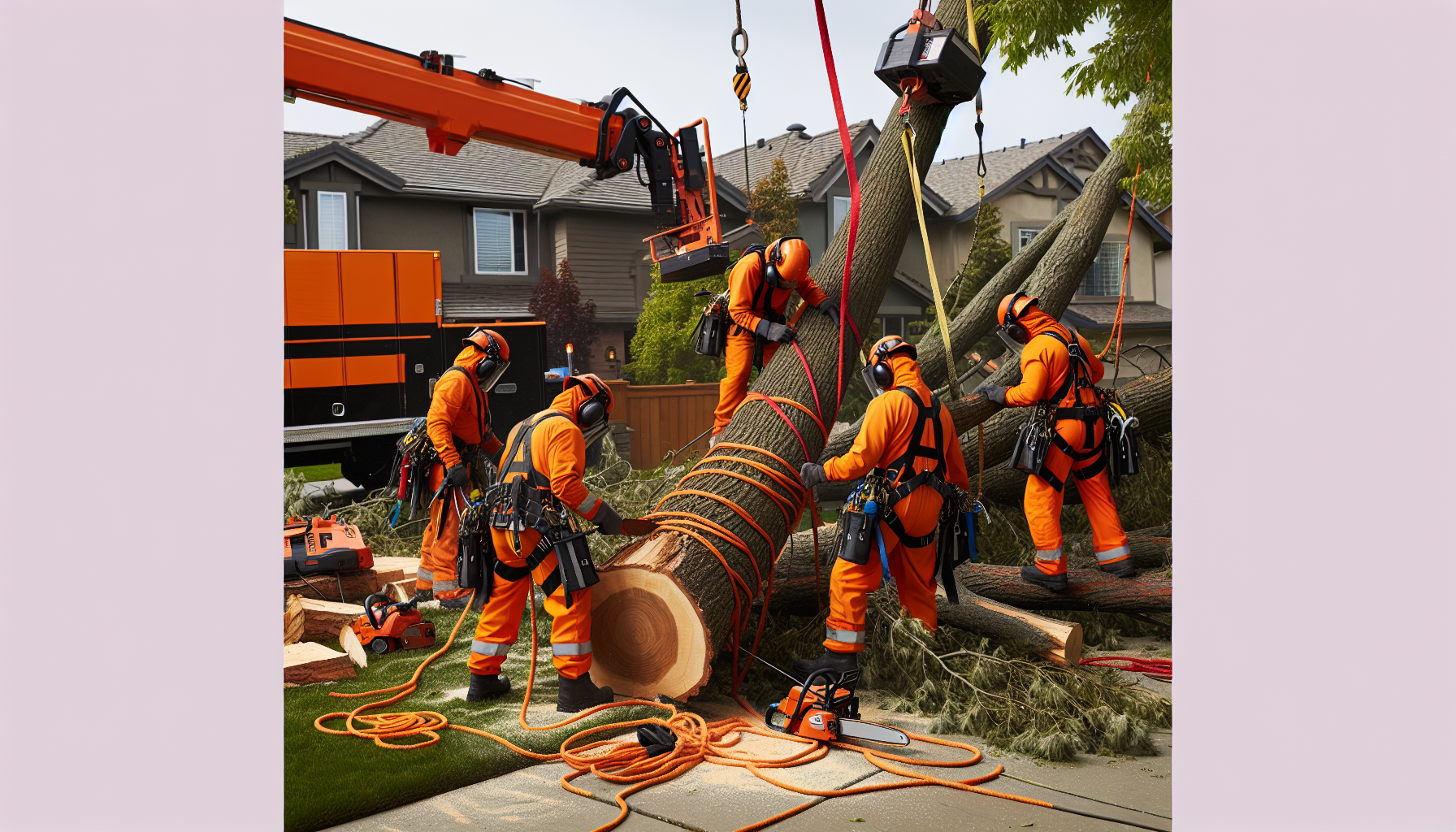
When dealing with a fallen tree, safety should always be your top priority. Hiring professional tree removal services can ensure safety by properly handling dangerous tools like chainsaws, especially after a major storm. But what about the costs involved?
The cost to remove trees is primarily determined by their size, species, and demands of the job, with additional factors such as geographic location, travel distance of the service, time of year, physical obstacles, and the need for crane rental also impacting the overall expense. On average, tree removal can cost around $750 per tree, with emergency removal costing between $450 and $3,000 depending on the urgency and complexity.
Why You Should Hire a Professional Tree Removal Service
Dealing with a fallen tree is not a DIY job. Professional tree removal services have the expertise to handle heavy branches safely, thus reducing risks to people, pets, and property. They are trained to safely climb trees and operate trimming and pruning tools, minimizing the risk of injury to homeowners.
Additionally, professional services are equipped to efficiently handle the removal process, reducing the time and effort required by you. So, while it may seem tempting to handle the task yourself, remember that the risks involved are high and the task is best left to professionals.
Comparing Tree Removal Estimates
Just as you would compare estimates for any major home improvement project, it’s crucial to compare tree removal estimates as well. Tree removal costs can vary based on several factors including the type of tree, location, and season.
For instance, palm and fig trees usually incur higher removal costs because they have extensive root systems. The cost of tree removal services is generally lower in rural areas compared to urban areas and is often less expensive in Southern states relative to Northern states due to higher demand in the North. Comparing estimates can help you understand the costs involved and make an informed decision.
Preventive Measures: Reducing Risks of Falling Trees
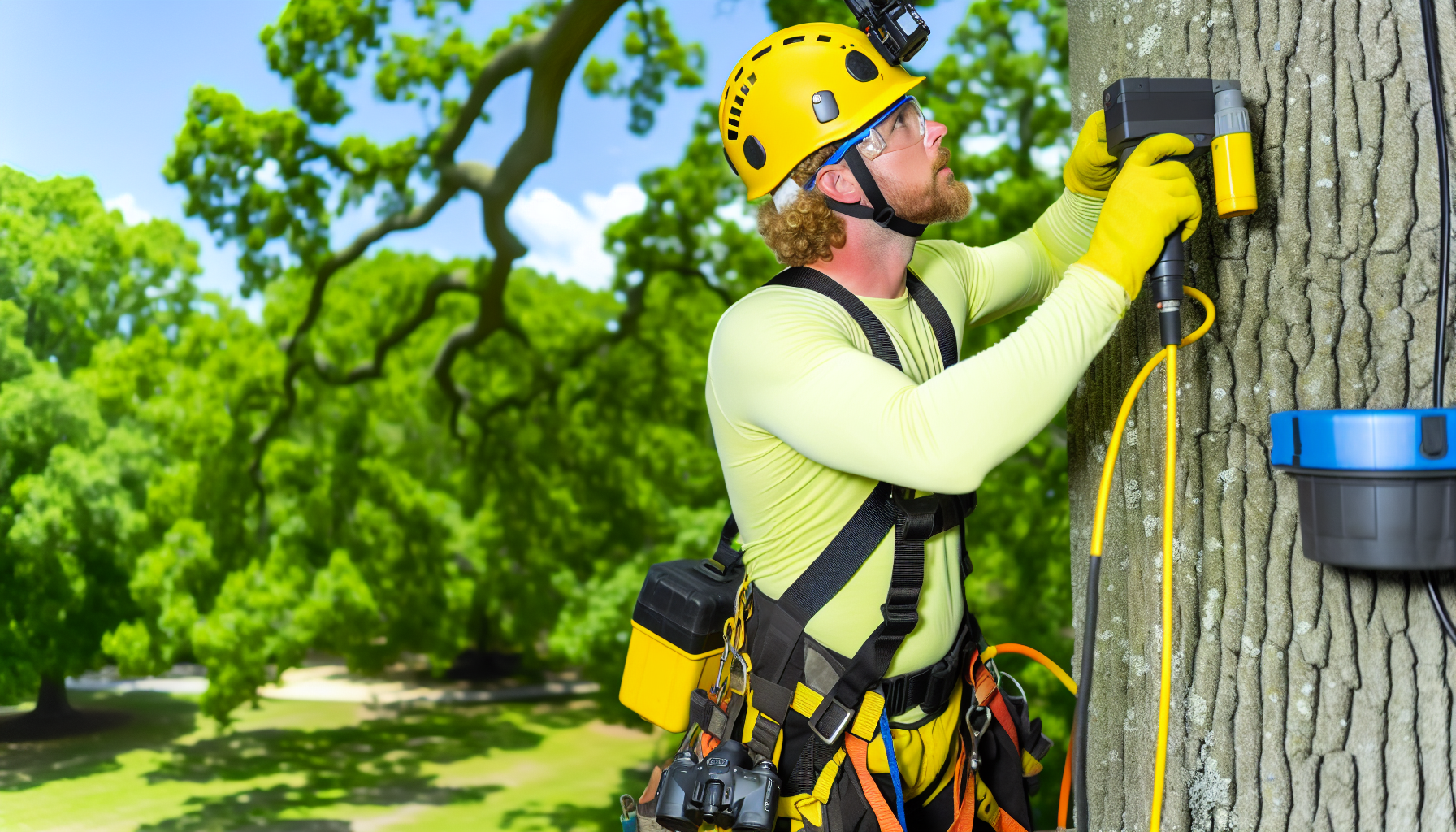
Prevention is better than cure, and this axiom holds true in the context of fallen trees as well. By taking preventive measures like regular tree inspections and maintenance, you can significantly reduce the risks associated with falling trees.
To prevent fallen trees from causing damage to your property, it is recommended to hire a licensed arborist for regular tree inspections and maintenance. This will help ensure the safety and health of your trees. Regular pruning of trees can remove potential hazards and maintain the health of the tree, thereby reducing the risk of it falling.
The Importance of Regular Tree Inspections
Performing regular tree inspection is a critical step in maintaining the health of your trees and preventing falls. These inspections can help detect decay, disease, or structural issues that may indicate potential safety hazards.
While homeowners can look for obvious defects like dead branches or decaying areas, these inspections may not reveal all potential risks. Therefore, having your trees inspected by a certified arborist can be invaluable. They are trained to assess complex aspects of tree health, such as root systems, trunk damage, and tree stability, to determine if a tree poses a risk and should be removed.
Maintaining Trees to Prevent Falls
Apart from regular inspections, maintaining your trees is an effective way to prevent falls and ensure their health and stability. Regular pruning, for instance, is essential to sustain a tree’s health and stability. But what if a tree has weak or hazardous branches?
In such cases, cabling or bracing provides supplementary support, minimizing the risk of these branches falling. Ensuring branches grow in broad U-shapes rather than V-shapes can prevent weak points that might break during strong winds. With proper tree maintenance, you can avert hazards and ensure the longevity of your trees.
How Public Land Factors Into Fallen Tree Responsibility
You might be surprised to learn that public land can also factor into fallen tree responsibility. Community officials are responsible for having fallen trees from public land removed, including those that fall onto private property. However, homeowners may need to utilize their insurance policies for repair costs due to damages.
In cases where a fallen tree from public land does not cause damage, the responsibility for removal may not be crystal clear, possibly requiring private intervention for removal. Further, if a tree on public land falls and interferes with power lines, it is the municipality’s responsibility to coordinate the necessary repairs.
The Impact of Severe Weather on Fallen Tree Responsibility
Severe weather events often exacerbate the problem of fallen trees. They can cause healthy trees to topple and amplify the damage caused by already hazardous trees. In such scenarios, homeowners insurance may cover the cost of tree removal if the tree falls due to a covered event like strong winds or lightning.
However, even in these circumstances, potential disputes can arise. For instance, if a tree falls due to severe weather, neighbors who have maintained their trees responsibly might not be liable for damages caused by their trees falling on someone else’s property. This emphasizes the need for clear communication and understanding of insurance policies in the face of severe weather events.
Addressing Fallen Trees and Power Lines
Fallen trees can become even more hazardous when they interfere with power lines. Utility companies are primarily responsible for:
Clearing fallen trees from power lines
Repairing any damage to their equipment
Engaging in preemptive trimming or removal of trees to prevent them from falling on power lines.
As a homeowner, if you notice a fallen tree near power lines, your first step should be to report the situation to your local utility company immediately. It’s important to remember that you should never attempt to remove the tree yourself due to the risk of electrocution. Safety should always come first.
Summary
Dealing with fallen trees can be a complex issue, involving the understanding of property lines, tree ownership, and insurance policies. Regular tree maintenance and proper care can minimize the risks of falling trees. However, when a tree does topple, knowing your rights and responsibilities can help in effectively managing the situation. Always prioritize safety, whether it’s in approaching a fallen tree or in deciding to remove a potentially dangerous one. After all, a little knowledge and preparedness can go a long way in preventing a fallen tree from becoming an overwhelming ordeal.
Frequently Asked Questions
Whose responsibility is it when a tree falls?
When a tree falls, it is generally considered the responsibility of the homeowner where the fallen tree was rooted. However, the neighbor’s insurance policy should cover damages under perils, unless the homeowner is found liable.
What is the tree law in Arkansas?
The tree law in Arkansas, as per Arkansas Code Annotated 18-60-102(a), states that any person who damages or destroys a tree on another person’s land is liable to pay the injured party triple the value of the tree. This law aims to protect trees on private property.
What is the tree law in Wisconsin?
In Wisconsin, all trees on land over which any highway is laid out belong to the owner of the land, except those acquired for public use in the acquisition of the highway right-of-way.
Does homeowners insurance cover fallen tree removal?
Yes, homeowners insurance may cover the cost of tree removal if the tree falls due to a covered event like strong winds or lightning, especially when it damages an insured structure.
What if a neighbor’s tree falls on my property?
Your homeowners insurance is typically responsible for covering the damages if a neighbor’s tree falls on your property. It’s important to contact your insurance provider as soon as possible to start the claims process.



